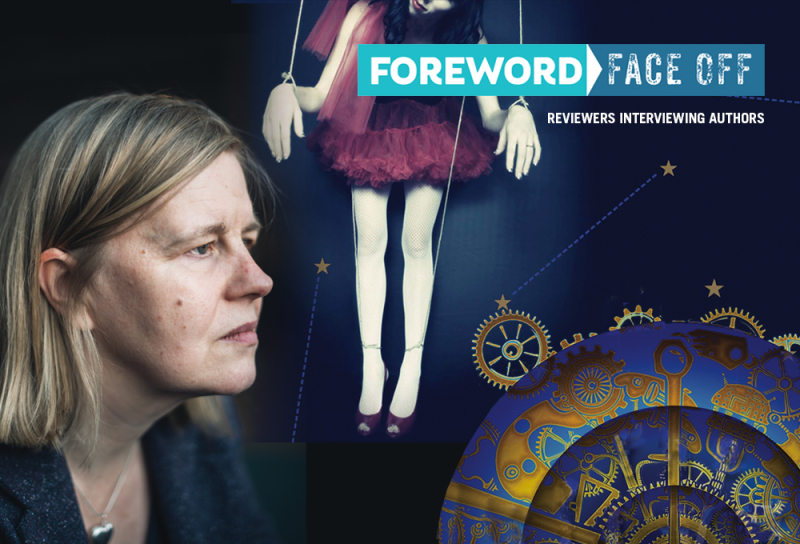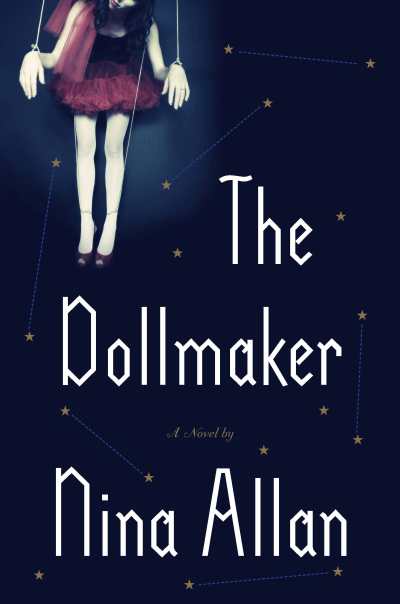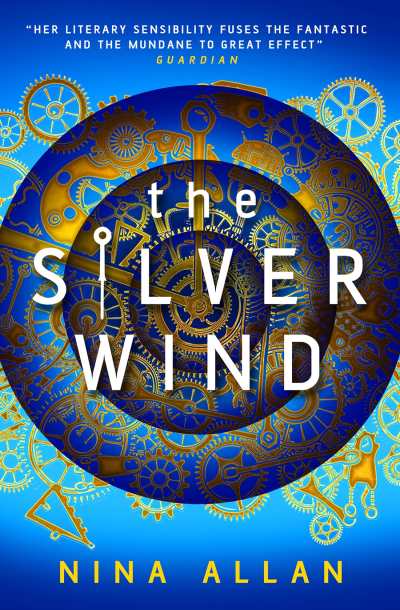Reviewer Michelle Anne Schingler Interviews Nina Allan, Author of The Dollmaker and The Silver Wind



We always imagined these Foreword FaceOff interviews to be—secretly, perhaps—a reviewer’s dream come true. The chance to ask a favorite author a slew of questions about anything at all, what’s not to love?
And don’t think our editorial team is immune to that sense of giddy excitement—Managing Editor Michelle Anne Schingler most of all. She’s an insatiable reader, and when she discovers someone extraordinary, as in the case of Nina Allan, all bets are off. In an unprecedented showing of esteem for a single author, Michelle chose to review Nina’s latest two books—The Dollmaker and The Silver Wind—in the September/October issue of Foreword Reviews.
As a general rule, we’re reluctant to feature writers of fiction in these interviews, because, well, the conversations can sometimes feel lighter than air. But the combination of Michelle’s sure hands and Nina’s marvelous gift of storytelling offered the exact right conditions for a fascinating conversation.
Michelle, get the party started.
Andrew and Bramber both belong to a community of collectors for whom antique dolls represent something often very personal that’s missing, or broken, or cherished in their lives. Are you a collector of anything? If so, what, and why does that speak to you? If not: what was it about collecting that felt like the beginning of a story to you?
The art of collecting—and I do see it very much as an art—is something that has fascinated me since I was a child. I always loved visiting museums—both the large, showcase museums such as the V&A (Victoria & Albert) and the Museum of Natural History in London but also the smaller and often much stranger local museums, which are often the perfect place to stumble upon the unexpected. Provincial museums tend to source the bulk of their collections from the bequests of local dignitaries, and so the collections you can see there are often quite arbitrary, depending on who left what to the museum and when. I love the darkened, silent rooms, the sense of being given permission to wander around inside other people’s lives. Victorian collectors often went to extraordinary lengths to acquire specimens, and the histories of their passions and feuds are marvellous stories in their own right. I think I’m attracted to these kinds of narratives because they contain something of the drama of family feuds, with an extra dash of targeted obsession.
Although I dabbled in collecting as a child—I did at one point possess about fifty costume dolls from the various European countries I had visited—I do not now in practice have the time and space to give the pastime the attention and care that it deserves. There is a whole lot of difference between creating a meaningful collection and accumulating unnecessary clutter, and as I have a personal horror of the latter I find that these days I’m more than content with reading and writing about other people’s cabinets of curiosities!
The Dollmaker includes Ewa Chaplin’s eerie, seemingly prescient tales. They’re a beautiful book unto themselves. Often times, books within books go very wrong (quality drops off, et cetera); how did you assume a fictional author’s voice so well, and did you experience any challenges in the process?
I have been hugely gratified by the way readers seem to be taking Ewa’s stories to their hearts, so much so that I am even considering completing her Nine Modern Fairytales at some point, as a book in its own right, with a few additional metafictional twists thrown in, no doubt.
As both reader and writer, the formal aspects of narrative—how a story is told—are of paramount importance to me. I love novels that play to the strengths of the written word, that perform tricks and turns of artifice that are not possible in other media, or at least not in the same way. It always feels like cheating to say so, but creating the kind of fractured narrative that characterises both The Dollmaker and The Silver Wind has always come naturally to me—it feels like the most normal way of telling a story, because it so perfectly echoes the tangents and flashbacks and snatches of associated stories that populate anecdotes and oral narratives—stories on the ground, if you like.
I have to say that creating Ewa’s stories was the most fun and delicious part of writing The Dollmaker because speaking through Ewa allowed me to go a bit crazy! Bramber’s letters and Andrew’s narrative are both quite bleak, in places, as stories of estrangement and trauma are wont to be. I wanted Ewa’s stories to be a deliberate contrast, not just in their more overt use of the fantastic but in their humour and—occasionally—ruthlessness. The moment when I realised that Ewa’s fairy tales had to form a significant, parallel narrative thread was a genuine turning point in the writing of The Dollmaker. Up till that point, the stories were more fragmentary. Writing them for real was a revelation.
The first movement of The Silver Wind begins with Owen making a choice (conscious or not) to build a watch that he’s told will be used to test the fabric of time. But was it really a choice, or is there an element of predetermination, personal or otherwise, at work in his decision? Can you speak a bit to that moment in his life, and to the implications it has for the rest of the characters in the book?
I actually think it’s useful to compare Owen with Andrew (in The Dollmaker) at this point. Both are isolated characters, not just in terms of their physical difference but in terms of their visionary outlook. They find it hard to form lasting relationships with the more pragmatic people around them. Owen grows up in a rural community, so he is isolated geographically as well. These characters would appear to be born with a sense of yearning for something beyond themselves, as well as great intellectual curiosity. Characters like Owen and Andrew form the bedrock of my fiction, really—I like their quiet defiance, their steely determination. They’re revolutionaries, but quiet revolutionaries, dealing in ideas rather than violence. But as Shelley once said, poets are the unacknowledged legislators of the world. I think Owen was always going to change the world in some way—and I do think he’s secretly excited by the power he has. He continues with his work on the watch, even in spite of its possible dangers, because he feels driven to explore the limits of what is possible.
Stories with multiverse angles are fascinating, but always make me wonder about what might be going on in the infinite other universes. What do you imagine other Nina Allans are doing across the multiverse—and what do you imagine they’re like?
I think I’m more like Owen and Andrew than I might care to admit! I’m sure that wherever I am and whatever I’m doing, there’ll be an obsessive, interior quality to it that is hard to deflect…
What movement/moment in The Silver Wind is most the reality that you’d like to exist in, and why?
The reality in “Time’s Chariot” is very much wrapped up in my mind with the time in which I wrote it—when I first moved back to London. Blackheath and Greenwich Park, the Chinese restaurant where Martin celebrates his birthday—they’re all real and redolent of the particular area of southeast London I was living in. As I say in the introduction to the book, all the Londons of The Silver Wind are, in a sense, my London, but this one most of all.
I don’t think I’d like to be born into the militarised, sectarian version of Britain we see in the middle story of the cycle, but I’m rather afraid we’re moving closer to it!
I know that The Rift has been out for a bit and we’re supposed to be focusing on your two amazing forthcoming novels, but I went on a bit of a Nina Allan bender after The Dollmaker, and I have to know: was she there? Slash does it matter, and why or why not?
I am interpreting this as a question about Julie, and whether or not she was really transported to the planet of Tristane or whether her “journey” was a delusion born of trauma! I might begin by telling you that The Rift is just one episode in a loose sequence of novels I have in mind—stories I have been thinking about, off and on, for the past five years and more. One of those novels will take place entirely on Tristane, and will tell the story of the creef invasion from the point of view of a gem hunter, living in the northern belts. I realise this doesn’t exactly answer your question, except in clarifying that Tristane and its six great city-states persist in my imagination very strongly…
The short answer is, I don’t think it matters. Two of my favourite novel-sequences, Christopher Priest’s Dream Archipelago books and M. John Harrison’s Viriconium cycle, make free use of these kinds of ambiguity, presenting invented worlds simultaneously as metaphor and as a concrete reality. I would say that how narrative is interpreted is very much up to each individual reader, and whatever answer they decide on would be equally valid.
Following up on that: the endings of your novels have an intentionally ambiguous quality that, while it means that burning questions aren’t given definitive answers, is somehow still so satisfying. What appeals to you about this kind of inconclusive conclusion?
I like to think of my endings as intentionally ambiguous, as you say, but with room for hope. This really is hugely important to me—to leave a story while there is still a sense that there is more to know, that the lives of the characters are continuing beyond the page. As a reader, my best test of a novel’s quality is whether I feel I’d want to reread it, and the novels I most want to reread are those in which there are no tidy conclusions. I enjoy a good thriller as much as anyone, but the problem for me with books that have that kind of propulsive, inexorable momentum is that once you know what happens there is little reason to revisit the book. I love novels with hidden corners and secret cul-de-sacs, novels where a supporting character might turn out to be the hero next time around.
I guess the shorter answer to this question is that I write what I like to read!
Michelle Anne Schingler
